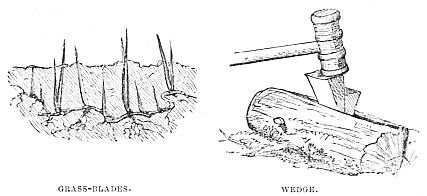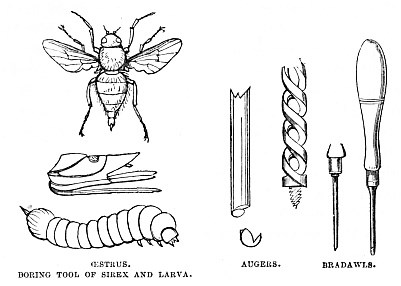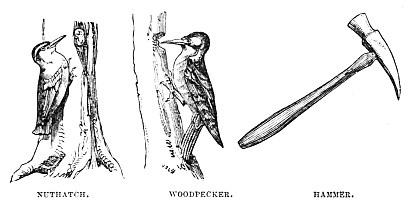 полная версия
полная версияNature's Teachings
NEXT in importance to the edged tools which cut, come the pointed tools by which holes can be bored. We have an abundance of such tools, but they can all be reduced to two types, namely, those which, like the Bradawl, are forced between the fibres, and those which, like the Gimlet, cut away the material as they pass through it.
They may, again, be shown to be different modifications of a single principle—i.e. that of the Wedge or Inclined Plane, which, as has already been shown, is identical with that of the screw. The Bradawl is, in fact, a sharp wedge, which is forced through the fibres, sometimes being merely forced between them, and sometimes cutting them, and thus forcing aside the severed fibres.
A natural example of the Bradawl is to be found in various Ichneumon-flies, especially those with very long ovipositors, which are intended for boring into wood.
All the Ichneumons are parasitic, laying their eggs in the larvæ of other insects, mostly those of moths and butterflies. Generally these larvæ exist in the open air, and the Ichneumon-fly has little difficulty in piercing them. But there are some which live either in wood or underground, and, in order to reach their hidden bodies, the Ichneumon is furnished with an extremely long and sharply pointed ovipositor.
This wonderful instrument is not so thick as an ordinary horsehair, although it is composed of three portions, and seems to be utterly inadequate to the task which it has to perform. Ascertaining by its instinct the exact locality of the caterpillar which it desires to pierce, the Ichneumon-fly clings firmly to the tree, bends the body so as to bring the point of the ovipositor against the wood, and, by moving the abdomen backwards and forwards, gradually works the instrument into the wood, sometimes piercing it to a considerable depth.
Mr. Westwood once saw an Ichneumon-fly thus boring its way into a dry post, the wood of which must have been very hard. When she had bored far enough, she partially withdrew the ovipositor, and then re-plunged it into the hole that she had made, as if she were depositing eggs. While engaged in this operation, she stood very high on her long legs, resting only on the extremities of the feet. She belonged to the genus Pimpla.
The principle of the Wedge or Inclined Plane is admirably shown by objects which we pass unheeded every day, and yet afford wonderful examples of the power of the wedge.
Scarcely any vegetable growth is so plentiful as grass, which has been used in that sense by the highest of all authorities, “which to-day is, and to-morrow is cast into the oven.” Grass forces its way everywhere—not only in cultivated grounds, but in the wildest of lands, where there is scarcely any nurture for it. Even among the habitations of mankind the grass will have its way, and clothes deserted housetops with verdure, and forces itself between the stones that pave neglected streets.
Place side by side some of these stones, together with a very young and tender Grass-blade, and it will seem to be impossible that so fragile an object should be able to exert any influence on the solid stone. Let any one try to push a sharp skewer between the stones, and he will find that he has to exert power sufficient to crush a thousand grass-blades. Yet these slight and delicate objects will force themselves between the stones, and sometimes to such an extent as to cover the whole roadway with verdure.
The force which is employed is simply marvellous, and can only be appreciated by those who know the resisting power of earth, however dry and loose it may be. Even sand has so strong a resistance that tents can be pitched in the desert without difficulty. Of course the ordinary tent-peg would be useless, but the desert dwellers can pitch their tents with perfect security. They fasten the tent-rope to a branch or piece of bush, scrape a hole in the sand, put the bush into the hole, cover it up again, and it will withstand almost any strain, though it be only covered with a few inches of sand.

When miners blast rocks with gunpowder, they take advantage of the resisting power of sand. They bore a suitable hole, place a charge of gunpowder at the bottom, and then merely pour loose sand into the hole until it is filled. When the powder explodes, the rock or coal is shattered to pieces, but the sand is not blown out of the hole. This operation is called “tamping.”
Every one, again, knows how firm are gate-posts, and how they resist the weight, jarring, and leverage of a heavy gate, all because they are sunk a little way into the earth.
Considering, therefore, that such fragile things as young grass-blades can force their way through the superincumbent weight, we can but be amazed at the aggregate of active force which is in full operation in every pasture field and garden lawn.
As far as I know, not being much of a botanist, every seed that springs up does so on the wedge principle, though the form of the wedge may be varied.
A terrible example of the force which is exercised by this principle among the vegetables is shown in some parts of the world where the Aloe flourishes in a wild state. In our colder clime the Aloe, though it does live in the open air, is a slow-growing plant. But, in its own land, it shoots up with a surprising vigour, and its sharply pointed and saw-edged leaves are said to grow to the extent of six inches in a single night.
Taking advantage of this rapid, and, at the same time, powerful growth, the natives, when they want to punish a man with more than ordinary severity, tie him hand and foot, and bind him to the earth just over a sprouting aloe plant, and leave him there. In twenty-four hours the man is nearly certain to be dead, the aloe-leaf having forced itself completely through his body. Or, if he be not actually dead, he lives in frightful tortures, which are continually increased by the flinty point and notches forcing themselves slowly, but surely, through the body.
For an example of the Gimlet we may take the ovipositor of the Sirex, an insect which I believe has no popular name. It is coloured much after the same manner as the hornet, and is often mistaken for that insect by those who are not versed in entomology. And, as its long and straight ovipositor is generally taken for a hornet’s sting, the insect assumes a double terror to the ignorant.
Now, the real fact is, that in its larval stage of existence the Sirex feeds upon the wood of the fir-tree—a diet which, to our ideas, is about as unsatisfactory as can well be imagined. In order that the young Sirex may be within reach of food, the egg must be introduced deeply into the body of the tree, and, for the egg to be so received, a channel must be cut for it.
This is done by means of the marvellously formed ovipositor. Many admirable descriptions have been given of the head of this instrument and its boring powers, but I am not aware that any one has noticed the secondary cutting blades that are set along the shaft of the principal borer, and which answer exactly the same purpose as the spiral cutting edge of the gimlet or auger.
Not being desirous of repeating my own observations in different words, I transfer to these pages a short account of the ovipositor of the Sirex, as examined by me when writing my work on British Insects, entitled “Insects at Home,” and published by Messrs. Longmans and Co.:—
“I very strongly recommend any of my readers who may obtain a female Sirex to disengage the actual borer from its two-bladed sheath, and examine it with the aid of a microscope. A half-inch object-glass will give quite a sufficient power.”

“It is straight, stiff, and elastic, as if made of steel, and, if bent, will spring back to its proper form with the elasticity of a Toledo rapier.
“But the borer possesses an auxiliary cutting apparatus which places it far above the rymer in point of efficacy. Even with an ordinary magnifying lens, it is easy to see that the end of the borer is developed into a sharp head, very much resembling that of a boarding-pike, and that the outline of the shaft is broken into a series of notches.
“The half-inch glass, however, discloses a marvellous example of mechanical excellence. The head of the borer is then seen to be armed with long, sharp teeth, slightly curved inwards, and acting just as does the carpenter’s ordinary centrebit.
“So much for the head of the borer: we will now turn to the shaft.
“It appears that, in order to make a clean-cut hole for the reception of the egg, the shaft of the borer has to finish the task which the head begins. Accordingly, it is armed on each of its sides with a series of hard, sharp-edged ridges, running diagonally across it, and acting exactly as do the sharp ridges of a coffee-mill.”
In point of fact, the ovipositor of the Sirex is the natural type of the improved gimlet of the present day. Instead, however, of having a single, spiral, sharp-edged groove running along the whole length of the shaft, it has a series of small, sharp blades, set exactly in the same line as is taken by the spiral groove, and acting in exactly the same manner—i.e. by cutting out successive portions of wood, and, by the diagonal position of the blades, throwing out the debris as fast as it is cut.
I cannot but think that, if any modern tool manufacturer could take as his model the saw-like ovipositor of the Tenthredinidæ, and the auger-like ovipositor of the present insect, he would produce a series of most valuable implements, possessing powers far beyond those of ordinary tools.
These short blades are arranged just like the “studs” on modern shells, and very much resemble them in shape, though not in material.
The Auger finds also a natural representative in the ovipositor of an insect.
That of the common Gad-fly (Œstrus bovis) is most beautifully constructed. It is tubular in form, and is of a telescopic nature, consisting of four tubes of different sizes, the smaller fitting into the larger just as is done with the joints of a common telescope, or those of a Japanese fishing-rod.
The end of the ovipositor is developed into little projections, some of which are armed with hard, sharp points, which act exactly like the cutting edge of the auger. This elaborate appliance is necessary on account of the thick, tough skin of the ox, which the Gad-fly has to penetrate before it can deposit its eggs. Perhaps the reader may be aware of the fact that the modern system of cutting channels in stone with the diamond point, as was so well exemplified in the Mont Cenis Tunnel, is but an imitation, and an imperfect one, of the method adopted by the Gad-fly. We shall soon recur to this instrument.
Striking ToolsIf we search the records of antiquity as left by races of men that have for countless ages vanished from the face of the earth, we shall find that in some shape or other the Hammer was a tool in constant use, and that in principle, though not in material, there was no difference between the Hammer of the Stone Age and that of a blacksmith of the present day.
The development of the instrument can easily be traced, especially as it is a tool which does not admit of much elaboration.
The original hammer was evidently a simple stone, and answered equally as a tool and a weapon. As, however, man progressed towards civilisation, he found that the stone itself was insufficient for his needs, and that he required much more force. The most obvious mode of doing so was to take a larger stone, but this expedient soon became valueless, inasmuch as a large stone was a cumbrous instrument to handle, and could not be directed with any certainty or delicacy.
The principle of the lever was then applied to the stone, which was affixed to a handle, and thus became elevated into the rank of a comparatively civilised tool. Sometimes the stone had a hole bored through it, into which the handle of the hammer was inserted, as is the case with most of our present hammers and pickaxes. Sometimes the end of the handle was enlarged, and the stone thrust through it, as is now done with the axes of Southern Africa. Sometimes a long, flexible rod was used by way of handle, the centre of it taking two turns round the stone, and the ends being lashed together. Handles thus made may be seen in any blacksmith’s forge of the present day.
The tool thus made was soon developed into various forms for different uses. By lengthening and pointing the head, it became a pick for loosening the earth. By widening and flattening the head, it became a hatchet; and, by performing the same alteration in the pickaxe blade, it became an adze. I possess a singularly ingenious tool from Borneo, in which the head is movable, so as to be used as a hatchet or adze at pleasure.
In Demmin’s “Weapons of War” many such hammers and axes are figured. One of them is very remarkable. It is an ancient war-hammer made of black stone, and is shaped exactly like a pickaxe, except that one end of the head is carved into a semblance of some animal’s head. The handle is passed through an oval hole in the centre, just like our pickaxes of the present day. This remarkable example of the art of the Stone Age was found in Russia. The head was nearly a foot in length.
Nature possesses many examples of this principle, of which I have chosen two, namely, the Woodpecker and the Nuthatch.

The wonderful power of beak possessed by both these birds is familiar to every one, but it is not so generally known that they do not merely peck after the usual fashion among birds, i.e. delivering the stroke with the force derived from the neck alone. These birds have an additional leverage. Grasping the tree firmly with their feet, they not only peck, but swing their whole bodies with each stroke, bringing their weight to bear upon the object. They thus convert themselves into living hammers, the feet acting the part of the human hand, the body of the bird being analogous to the handle of the hammer, and the head playing the same part in both cases.
In England these birds are not known as well as they ought to be, partly because they are both very shy creatures, and partly because the gradual extinction of forests has deprived them, and especially the Woodpecker, of their undisturbed homes. Yet those who are early risers may see both birds in places where their presence is quite unsuspected, except, perhaps, by those who can recognise the signs which they have left behind them.
There is a common saying to the effect that “a carpenter is known by his chips,” and the proverb is equally true of the Nuthatch and the Woodpecker. Nutshells scientifically split asunder, and jammed into the rough bark of a tree-trunk, betray at once the Nuthatch to the eye of a naturalist; while an accumulation of shattered bark, splinters of wood, and similar debris announces, in equally bold type, that a Woodpecker has been at work.
The power of the Woodpecker’s beak may be gathered from Wilson’s well-known account of an Ivory-billed Woodpecker, which he had wounded and was trying to rear. While staying at an hotel, he locked the bird in his room, and, on returning within an hour, found an astonishing state of things.
“He had mounted along the side of the window, nearly as high as the ceiling, a little below which he had begun to break through. The bed was covered with large pieces of plaster, the lath was exposed for at least fifteen inches square, and a hole large enough to admit the fist opened to the weather boards, so that in less than another hour he would certainly have succeeded in making his way through.
“I now tied a string round his leg, and, fastening it to the table, again left him. I wished to preserve his life, and had gone off in search of suitable food for him. As I re-ascended the stairs, I heard him again at work, and on entering had the mortification to perceive that he had almost ruined the mahogany table to which he was fastened, and on which he had wreaked his whole vengeance.”
The beak of the Woodpecker was employed upon its new master quite as forcibly as upon walls and furniture, but Wilson was of too generous a nature to resent his injuries, and lamented sincerely when the bird died.
The reader will probably observe that the Hammer which has been given as an illustration of this principle is the ordinary geologist’s hammer, and that it has been selected because its head is so formed that one end can be employed for the usual tasks of a hammer, while the other end, with its slight curve and sharp point, is, in fact, a sort of pickaxe, and used for the same purposes. Indeed, this instrument is an almost exact reproduction of the stone hammer which has already-been mentioned, the blunt end being represented by the carved head, and the sharp end by the pickaxe point.
Grasping ToolsAlready we have spoken of the Shears and Scissors, together with their mode of action and dependence upon leverage. We now come to a set of tools which, although equally dependent on leverage, develop that power by grasping instead of cutting. Without these tools, the arts and sciences could have scarcely made themselves felt, as there are but few manufactures in which the artificer does not require a grasping power far superior to that of the human hand.
Perhaps the enormous power of the Pincers is never shown to better advantage than in the great iron-works, where enormous masses of white-hot metal have to be brought under the blows of the steam hammer. I do not know of anything which affords a more imposing realisation of the Divine command that man is to subdue the earth as well as to replenish it. There is the vast hammer, striking blows which are felt throughout a large area as if a succession of earthquakes had been let loose. In the furnace there is an enormous mass of iron, heated to such a degree that an unpractised eye could no more dare to look at it than to stare a midsummer sun out of face.
Where are the armies who are to cope with such forces? A few stalwart and grimy men come forward, each man with a curious but unmistakable air of one who wages a war of giants. The furnace door is opened, and out rushes a blinding light which strikes on the eyeballs like a shock of electricity. The men seize the handles of an enormous pair of Pincers, suspended in the middle by a chain, and though no unpractised eye can distinguish the glowing iron from the enveloping fire, they run the Pincers into the furnace, seize the iron, swing it to the anvil, and turn it this way and that way as easily as if it were a feather, while the blows of the gigantic hammer descend upon it, enveloping them in a torrent of sparks which spurt as if they were mere splashes of water, and seem to do them no more harm.
Taking the minor exposition of the Pincers principle and their use, we may mention the ordinary Pincers which are mostly used for drawing nails. Then there are the smaller Pincers called Pliers, all of which are constructed on the same principle, and the chief of which are the Round-nosed Pliers, the Long-nosed Pliers, and the Gas Pliers. Sometimes a mixture of the Hammer and the Pincers is ingeniously contrived, as in the tool which is represented on the right hand of the illustration.

Then we have the still smaller and feebler Pincers of civilised life, such as the Sugar-tongs and the ordinary Coal-tongs of our firesides. Anatomists could have had no practical existence without the Pincers, of which their beautifully constructed and much-elaborated forceps are but variations.
Take, again, the dentist, with his series of shining instruments, which he so carefully keeps out of sight until he has got his patient safely in that awful chair, and which glide, as by a conjurer’s trick, empty into an open mouth, and return in a few seconds with a tooth between their polished jaws.
All these instruments have their parallels in Nature, and in many instances the natural pincers might supply useful hints to modern tool-makers.
In the left-hand upper corner of the illustration is shown the common fresh-water Mussel, which is so plentiful in almost all our rivers and many of our ponds. Its scientific name is Unio margaritiferus. The latter title, which signifies “pearl-bearing,” is given to it because it furnishes the British pearls which were at one time so highly valued.
Like other bivalve molluscs, this Unio has the two halves of the shell fitting quite tightly upon each other, and, when they are drawn together by the contraction of the internal muscles, they can give a very severe pinch. In many uncivilised parts of the world the natives take advantage of this property, and use them as tweezers, chiefly for the purpose of pulling out hairs which they are pleased to think are not needed.
I need not state that with all bivalves the power is increased in proportion to the size of the shell. Even an Oyster can pinch most severely, while the Giant Clam, the shell of which weighs some four hundred pounds, could nearly take off a man’s leg if it seized him.
Mr. J. Keast Lord, in his “Naturalist in British Columbia,” relates an amusing story that was told to him by an old settler respecting the power of the Clam’s grip:—
“You see, sir, as I was a-cruising down these flats about sun-up, the tide jist at the nip, as it is now, I see a whole pile of shoveller-ducks snabbling in the mud, and busy as dogfish in herring time. So I creeps down, and slap I let ’em have it. Six on ’em turned over, and off went the pack, gallows scared, and quacking like mad.”
“Down I runs to pick up the dead uns, when I see an old mallard a-playing up all kinds o’ antics, jumping, backing, flapping, but fast by the head, as if he had his nose in a steel trap; and when I comes up to him, blest if a large Clam hadn’t hold of him, hard and fast, by the beak.”
“The old mallard might ha’ tried his hardest, but may I never bait a martin-trap again if that Clam wouldn’t ha’ held him agin any odds till a tide run in, and then he’d ha’ been a gone shoveller sure as shooting. So I cracked up the Clam with the butt of my old gun, and bagged the mallard.”
Of course the reader will remember that this was only an ordinary Clam, and not one of the giant race.
Below the shell are two very perfect instances of natural Pincers, each acting in a different manner, but on the same principle.
The Earwig is too familiar to need much description, but I may as well state that its pincers are not primarily intended as weapons, although they can be so used on occasion. (I was about to say, at a pinch, but refrain.) They resemble our ordinary pincers in that both blades move equally, and they are so completely under the control of their owner, that the insect uses them with a delicacy of touch that a lady’s fingers could hardly surpass. They are really tools, and not weapons, and are employed for the purpose of folding the wide and delicate wings under the tiny elytra.
There is another insect called the Scorpion-fly (Panorpa), the male of which is furnished with a pair of pincers at the end of a long and flexible tail, articulated just like the tail of a scorpion, and moved in exactly the same manner. It is but a little insect, but its gestures are so menacing as it flourishes its tail about, that non-entomologists may well be pardoned for being afraid of it. Moreover, small as are the pincers, they really can give a smart nip, and make themselves felt on the human skin.
If we want examples of exceedingly powerful pincers, we need only go to the Lobsters and Crabs, especially to the latter, whose claws are often of enormous thickness in proportion to the size of the animal. All those who have visited the seaside know how severe is the pinch of the common Green Crab, comparatively small though it be, and the same may be said of the river crayfish, which is, in fact, a lobster in miniature.
As to the lobster itself, fishermen are so well acquainted with the power of its claws, that they tie them together with string as soon as the animal is caught. Formerly they used to “peg” them, i.e. drive a wooden peg into the joint so as to prevent it from moving. This custom, however, is now prohibited by law on account of its cruelty.






